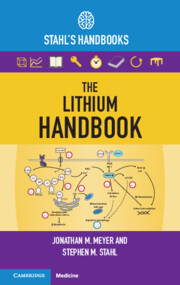Book contents
- The Lithium Handbook
- Reviews
- The Lithium Handbook
- Copyright page
- Contents
- Foreword
- Preface: How to Use This Handbook
- Introduction
- 1 The Efficacy Story
- 2 Renal Handling of Lithium
- 3 Clinical Pharmacokinetics
- 4 Lithium Initiation and Monitoring
- 5 Management of Routine Lithium Related Adverse Effects
- 6 Lithium Toxicity
- 7 Special Populations and Circumstances
- 8 Lithium Discontinuation
- Index
- References
7 - Special Populations and Circumstances
Older Bipolar Disorder Patients; Child and Adolescent Bipolar Disorder Patients; Pregnant and Breastfeeding Patients; Lithium Use During Renal Dialysis
Published online by Cambridge University Press: 09 February 2024
- The Lithium Handbook
- Reviews
- The Lithium Handbook
- Copyright page
- Contents
- Foreword
- Preface: How to Use This Handbook
- Introduction
- 1 The Efficacy Story
- 2 Renal Handling of Lithium
- 3 Clinical Pharmacokinetics
- 4 Lithium Initiation and Monitoring
- 5 Management of Routine Lithium Related Adverse Effects
- 6 Lithium Toxicity
- 7 Special Populations and Circumstances
- 8 Lithium Discontinuation
- Index
- References
Summary
The 2017 International Society for Bipolar Disorders (ISBD) Task Force report on pediatric bipolar disorder (BD) cemented the concept that BD can have onset before the age 18, and that establishing the diagnosis should be based on symptoms of mania or hypomania, while chronic irritability by itself is not sufficient to establish a BD diagnosis [1, 2]. A 2010 study of 1566 patients from six international sites documented that approximately 5% of BD-1 and 5% of BD-2 cases had onset before the age of 20 (Figure 7.1), although the authors noted that only 34.1% of patients were evaluated at onset of their BD, so investigators had to rely on patient recall for two-thirds of the sample.
- Type
- Chapter
- Information
- The Lithium HandbookStahl's Handbooks, pp. 362 - 427Publisher: Cambridge University PressPrint publication year: 2023



